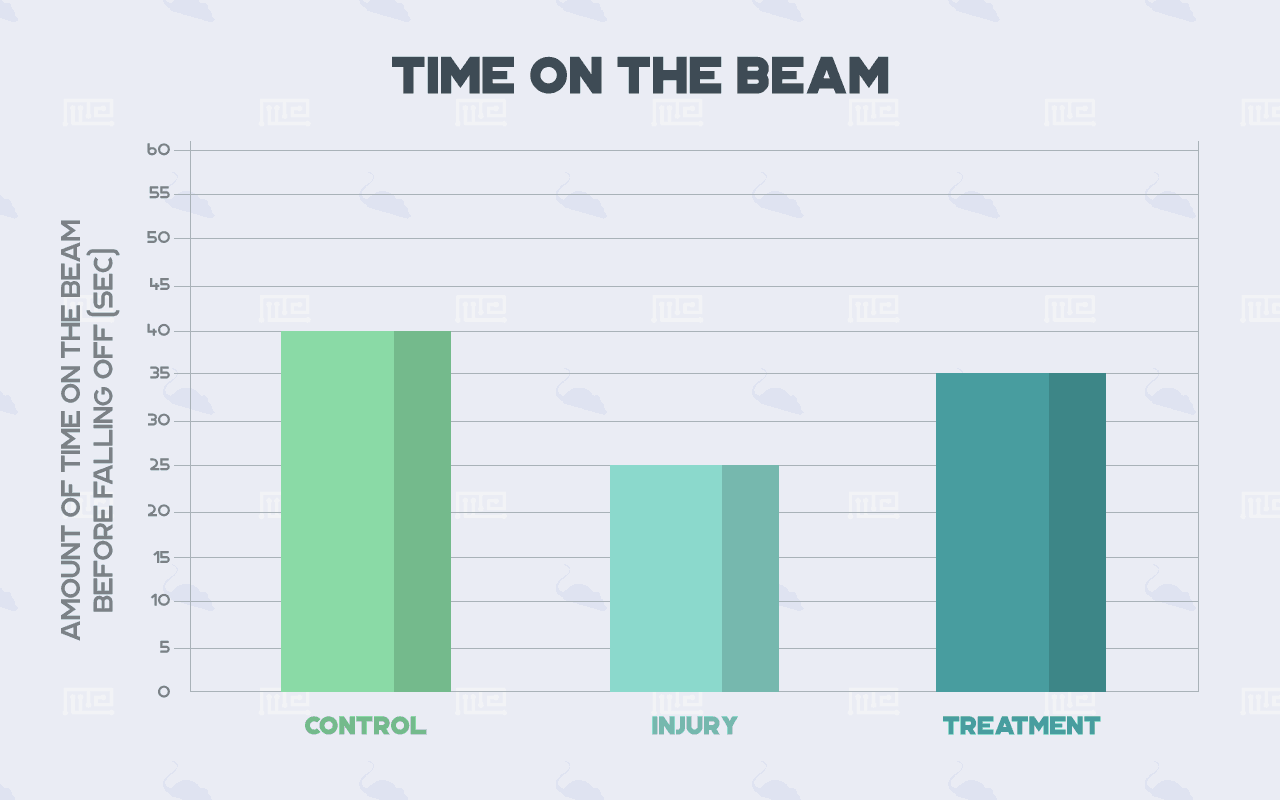Welcome back to Maze Basics! Today, we’re going to talk about the balance beam test. In gymnastics, the balance beam was an elevated beam that you carefully walk along, maintaining your balance. Just like in gymnastics, the balance beam test for rodents assesses motor coordination and balance. The apparatus looks just as you’d expect: a narrow walking bridge for mice and rats to walk across.
The Balance Beam Test
The balance beam test is fairly easy. Place the mouse or rat at the starting end and then encourage it to cross the beam to the other side. Researchers can then measure the latency to walk across or the number of foot slips. One commonly measured characteristic is the performance of the rodents’ hindlimbs. Their hindlimbs are not usually used for complex movement, so the foot slips are a good indicator of hindlimb functioning[1].
Metz et al. (2000) created a grading system for the balance beam test: “0” if the animal can’t stay on at all, “0.5” if it can make it halfway across before falling, “1” if it can make it all the way across, “1.5” if it partially uses its hindlimbs and makes it all the way across, and “2” if it travels across using its normal walking and foot placement pattern[2].
Luong et al (2011) report on a grading system that awards the rodent a “1” if it is unable to cross the beam and a “7” if it can make it all the way across while walking normally and fewer than two foot slips. If it drags its limbs, it’s considered a “3”. Many researchers also measure the average time to cross the beam, which measures how much they stall and sniff while in the middle of the beam[3]. Researchers also use the amount of time the animal can walk before slipping off (don’t worry, there’s a net to catch them!). There can be a variety of scales and measurements depending on who’s conducting the research, but they all rate motor coordination using roughly the same rubrics.
Applications of the Balance Beam Test
The applications of the balance beam test is where it becomes very practical and interesting. Researchers have used the balance beam laboratory apparatus to test the effects of strokes, Parkinson’s disease[4], Huntington disease[3], and traumatic brain injury[6]. In response to diseases that reduce motor ability or brain injuries to the cortex, the performances on the beam balance decrease. In other words, the disease or injury models will have more foot slips or spend less time on the beam before they fall off.
Perez-Polo et al (2013) looked at mice that were surgically induced to have moderate to severe traumatic brain injury. They found that after the injury, the amount of time the mice were able to stay on the beam and walk across decreased significantly. In addition, the injured mice had significantly more foot slips, for both the forelimb and the hindlimb legs.
Researchers use this test to study not only diseases and injuries, but also possible treatments. If the treatment works, then there should be a decrease in the number of foot slips and an increase in the amount of time the mouse stays on.
Some researchers have come to prefer the balance beam over the rotarod test since they have found this test to be more sensitive in detecting fine motor deficits[6]. However, if the diseased or injured rodents show too much-decreased motor function, the balance beam test is not likely to work. In this case, the rotarod test may be better because of its wider walking area. All in all, the balance beam is a simple and straightforward test of balance and motor coordination.
For more Maze Basics articles, visit our Maze Basics resource page.
References
- Schaar KL, Brenneman MM, Savitz SI (2010). Functional assessments in the rodent stroke model. Experimental and Translational Stroke Medicine 2(13).
- Metz GA, Merkler D, Dietz V, Schwab ME, Fouad K (2000). Efficient testing of motor function in spinal cord injured rats. Brain research 883:165-177.
- Luong TN, Carlisle HJ, Southwell A, Patterson PH (2011). Assessment of Motor Balance and Coordination in Mice using the Balance Beam. Journal of Visualized Experiments 49: 2376.
- Meredith GE, Kang UJ (2006). Behavioral models of Parkinson’s disease in rodents: A new look at an old problem. Movement Disorders 21(10): 1595-606.
- Perez-Polo JR, Rea HC, Johnson KM, Parsley MA, Unabia GC, Xu GJ, Infante SK, DeWitt DS, Hulsebosch CE (2013). Inflammatory Consequences in a Rodent Model of Mild Traumatic Brain Injury. Journal of Neurotrauma 30:727-740.
- Curzon P, Zhang M, Radek RJ, Fox GB (2009). The Behavioral Assessment of Sensorimotor Processes in the Mouse: Acoustic Startle, Sensory Gating, Locomotor Activity, Rotarod, and Beam Walking. In: Methods of Behavior Analysis in Neuroscience (Buccafusco, J. J., ed) Boca Raton (FL).


